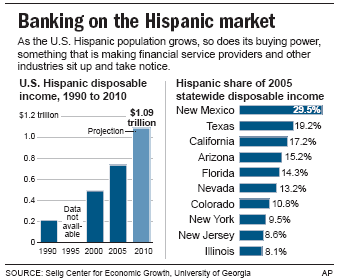Hispanic and Latino Community Remains Untapped Banking Market
March 7, 2013BY CANDICE REED
 Credit unions from the West Coast to the South and the Midwest are waking up to the fact that reaching out to potential Hispanic members is an important part insuring a growth for the industry.
Credit unions from the West Coast to the South and the Midwest are waking up to the fact that reaching out to potential Hispanic members is an important part insuring a growth for the industry.
According to U.S. Census Bureau estimates, there are roughly 52.0 million Hispanics living in the United States, representing approximately 16.7% of the total population, making people of Hispanic origin the nation’s largest ethnic or race minority. The U.S. Hispanic population is estimated to reach 132.8 million by 2050.
“Reaching and serving the Latino community is not only philosophically a good thing for our credit union, it is also an investment for membership growth for our credit union,” said Chad Cunningham a loan officer for the $385 million in assets Consumers Credit union in Kalamazoo, Mich. “We want to live out our mission statement of providing quality products and services that contribute to the economic and social well-being of our entire field of membership. It is essential that our strategies take into account the fact that the Latino population is currently the fastest growing demographic in Michigan. Over the past 10 years, while the total state population has decreased, the Latino population has grown 35%.”
 Consumers CU created a strategic Hispanic outreach plan as well as a local Hispanic businesses group, similar to a Hispanic chamber a commerce with the help of Des Moines, Iowa-based firm Coopera Consulting.
Consumers CU created a strategic Hispanic outreach plan as well as a local Hispanic businesses group, similar to a Hispanic chamber a commerce with the help of Des Moines, Iowa-based firm Coopera Consulting.
“To truly compete in a rapidly changing financial marketplace, credit unions must be strategic about their positioning within the communities they serve,” said Miriam De Dios, CEO of Coopera. “Not all credit unions have embraced the prospect of increasing efforts to attract, serve, and retain Hispanic and new American populations and I think this is still an untapped market.”
With the Hispanic population on the rise and nearly half of the Hispanic community lacking mainstream financial services, credit unions are in the perfect position to distinguish themselves from the competition, De Dios said.
“The Hispanic community can be very hesitant to join credit unions because of the history many have with the financial institutions in their home countries,” she said. “There are also policies that have been created that prevent Hispanic consumers from obtaining financial services. Without traditional forms of identification, Hispanics are reluctant to try and become members.”
 With that in mind, credit unions such as Security Service Federal Credit Union headquartered in San Antonio and Santa Cruz Community Union in Santa Cruz, Calif., accept the matricula card– a form of identification issued to Mexican nationals by consulates–as a valid form of identification to open a checking account.
With that in mind, credit unions such as Security Service Federal Credit Union headquartered in San Antonio and Santa Cruz Community Union in Santa Cruz, Calif., accept the matricula card– a form of identification issued to Mexican nationals by consulates–as a valid form of identification to open a checking account.
Late last year, the $103 million in assets Santa Cruz Credit Union hosted a Mexican consulate’s matricula ID event, and more than six hundred people attended to obtain identification cards. In the weeks following the event, account openings in the credit union’s Watsonville branch increased nearly 5% as a result of the credit union’s participation. California’s Hispanic population is 14 million, the highest of any state and in Texas, Hispanics are the fastest-growing population group, making up 38% of the population according to the U.S. Census Bureau.
Some credit unions struggle with persistent, yet false, assumptions that most of the Hispanic population is undocumented. A recent poll by the National Hispanic Media Coalition found that more than 30% of Americans believe that more than half of Hispanics are in the country illegally. The reality is that 37% of U.S. Hispanics are immigrants, and only 18% of Hispanics are undocumented.
 “We accept the matricula, and I know other financial institutions in the area do not, and I think that’s ridiculous,” said John Worthington, senior vice president for the $6.7 billion Security Service Credit Union. “This is an underserved population and we go above and beyond to serve our Hispanic members because we are all part of the same community.”
“We accept the matricula, and I know other financial institutions in the area do not, and I think that’s ridiculous,” said John Worthington, senior vice president for the $6.7 billion Security Service Credit Union. “This is an underserved population and we go above and beyond to serve our Hispanic members because we are all part of the same community.”
Once credit union are able to get Hispanic members inside their doors, there is still a lot of work to be done, De Dios said. “What we have seen is that Hispanic consumers prefer high levels of member service, valuing personal relationships over things like speed and efficiency,” she said. “We believe credit unions are well-suited to providing the Hispanic community with the financial services it needs.”
American Hispanics show a great deal of loyalty towards brands and companies that cater to their needs. When Hispanics find a product or service that they have confidence in, they tend to stick with it. Research by the Pew Hispanic Center has found that 61 % of Hispanics find it difficult to change brands once they find one they like. Further, 59% claim to have no time to investigate the quality of different brands. Given this reputation for brand loyalty, the Hispanic market should prove to be the credit union community’s dream said Worthington.
“It’s in a lender’s best interest to develop a strong relationship with the burgeoning Hispanic market,” he said. “We didn’t just discover this though, we’ve been serving this market for more than 50 years.”
Hispanics also have a purchasing power that’s expected to reach $1 trillion next year, according to the Selig Center for Economic Growth, Athens, Ga. And yet 40% to 55% of U.S. Hispanics don’t have a relationship with a traditional financial institution.
That’s a rich vein for credit unions to tap. With Hispanics’ wealth and population rising three times faster than the U.S. average, the FDIC predicts that they will account for more than 50% of U.S. retail banking growth over the next decade. That amounts to more than $200 billion in new business, since U.S. retail banking revenues are projected to increase 44%, to $963 billion over the decade, according to Economy.com.
A report commissioned by the California and Nevada Credit Union Leagues and Applied Research Institute conducted estimates for California and Nevada, estimating that if 10% of each state’s Hispanic adults were members of a credit union, the numbers would be compelling. In California, they would contribute an estimated $2.1 billion in loan balances and $592 million to annual income. Nevada’s Hispanic adults would contribute an estimated $82 million in loan balances and $28 million to annual income.
“Working closely with local organizations with deep connections to our Hispanic community is key,” said Elizabeth Carr, CEO of Santa Cruz Community Credit Union. “These partnerships provide a conduit for our credit union to do financial education, teach the value of saving, borrowing and credit building, as well as help underserved Hispanic members open accounts in a safe environment.”
